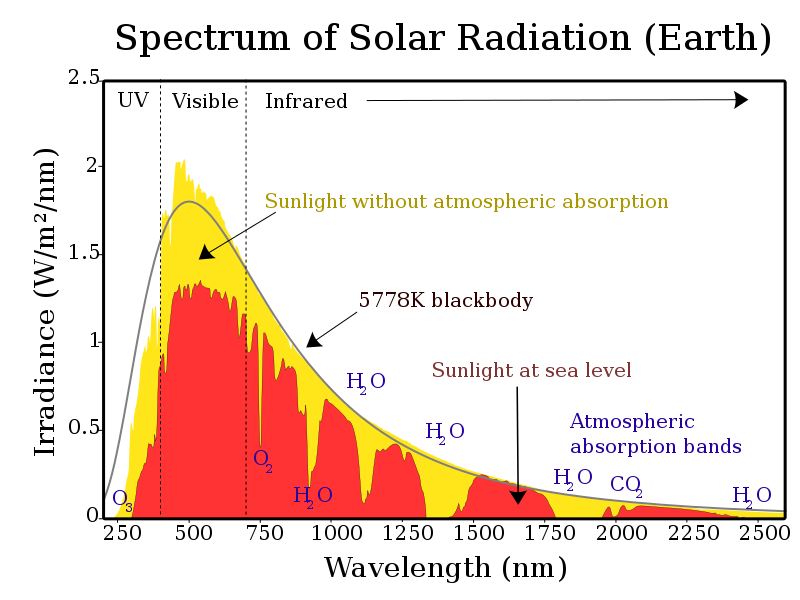Súbor:Solar spectrum en.svg
Vzhled

Veľkosť tohoto PNG náhľadu tohoto SVG súboru: 800 × 600 pixelov. Iné rozlíšenia: 320 × 240 pixelov | 640 × 480 pixelov | 1 024 × 768 pixelov | 1 280 × 960 pixelov | 2 560 × 1 920 pixelov .
Pôvodný súbor (SVG súbor, 800 × 600 pixelov, veľkosť súboru: 49 KB)
História súboru
Po kliknutí na dátum/čas uvidíte ako súbor vyzeral vtedy.
| Dátum/Čas | Náhľad | Rozmery | Používateľ | Komentár | |
|---|---|---|---|---|---|
| aktuálna | 16:10, 13. máj 2019 |  | 800 × 600 (49 KB) | Tuvalkin | It's W, not kW, as further discussed: Reverted to version as of 20:57, 21 February 2016 (UTC) |
| 14:13, 25. február 2019 |  | 800 × 600 (49 KB) | Tuvalkin | W → kW, as dicussed | |
| 20:57, 21. február 2016 |  | 800 × 600 (49 KB) | BenRG | Replace 5250°C blackbody (seemingly miscalculated anyway) with standard 5778K blackbody; center-align captions; use Unicode ² instead of SVG superscript to fix rendering problems | |
| 22:21, 7. január 2015 |  | 800 × 600 (50 KB) | Bendhoward | The Y-axis units were changed at some point to W/m^2, which is not correct. The units have been changed back to W/m^2/nm, in accordance with the units of the X-axis. | |
| 22:25, 4. september 2014 |  | 800 × 600 (50 KB) | TxBangert | ... changed ^2 to superscript | |
| 22:18, 4. september 2014 |  | 800 × 600 (50 KB) | TxBangert | fixed minor errors in how Wikipedia renders svg image | |
| 10:28, 4. september 2014 |  | 800 × 600 (50 KB) | TxBangert | Updated the text to bring it in more in line with other European versions of this graph. W/m2/nm on the y axis is wrong. The units are simply W/m2, the x axis is nm. | |
| 14:50, 4. marec 2013 |  | 800 × 600 (50 KB) | Arbeck | Typo corrected - Atmosphere | |
| 15:44, 14. február 2013 |  | 800 × 600 (50 KB) | Arbeck | Typo corrected: visible | |
| 15:44, 14. február 2013 |  | 800 × 600 (50 KB) | Arbeck | Typo correctedvisible |
Použitie súboru
Na tento súbor odkazuje nasledujúca stránka:
Globálne využitie súborov
Nasledovné ďalšie wiki používajú tento súbor:
- Použitie na ca.wikipedia.org
- Použitie na de.wikipedia.org
- Použitie na el.wikipedia.org
- Použitie na en.wikipedia.org
- Použitie na es.wikipedia.org
- Použitie na eu.wikipedia.org
- Použitie na hak.wikipedia.org
- Použitie na hi.wikipedia.org
- Použitie na hu.wikipedia.org
- Použitie na ig.wikipedia.org
- Použitie na ja.wikipedia.org
- Použitie na ms.wikipedia.org
- Použitie na pt.wikipedia.org
- Použitie na sl.wikipedia.org
- Použitie na te.wikipedia.org
- Použitie na uz.wikipedia.org
- Použitie na vi.wikipedia.org










